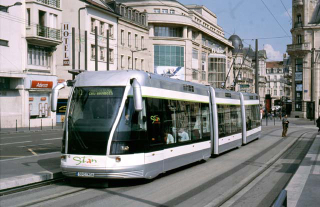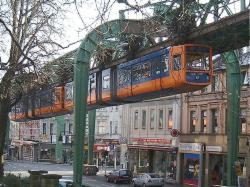 |
 The guided bus was developed as a low-cost alternative to light rail. These systems typically are similar to rubber-tired buses but also have another guidance system besides their wheels (which help stabilize the long buses). Three such systems are being considered for Milwaukee, the TVR (short for Transport sur Voie Reservé, or transport on a special route, image courtesy of Brian Lomas and John Laker), which utilizes guidence wheels pushed into a slot in the road as a guidance system, the Translohr, which operates in a similar manner, and Civis, which would be guided by the magnetic field of a cable under the street. Guided buses are powered by electricity except for on bridges and off-route, where diesel engines are employed. The buses would travel in dedicated lanes separate from other traffic.
The guided bus was developed as a low-cost alternative to light rail. These systems typically are similar to rubber-tired buses but also have another guidance system besides their wheels (which help stabilize the long buses). Three such systems are being considered for Milwaukee, the TVR (short for Transport sur Voie Reservé, or transport on a special route, image courtesy of Brian Lomas and John Laker), which utilizes guidence wheels pushed into a slot in the road as a guidance system, the Translohr, which operates in a similar manner, and Civis, which would be guided by the magnetic field of a cable under the street. Guided buses are powered by electricity except for on bridges and off-route, where diesel engines are employed. The buses would travel in dedicated lanes separate from other traffic.
 The Milwaukee monorail would be an updated version of the Wuppertal Schwebebahn, a suspended monorail that has been operating in Germany since 1901 (at left, picture courtesy of Peter Bosbach). This type of vehicle was designed by the German engineer Karl Langen and utilizes an electric vehicle hanging underneath a single rail. A Milwaukee monorail would have several important updates over the Schwebebahn, though. These include a less intrusive support structure that is supported by slender columns instead of the massive steel structure of the Schwebebahn, and linear induction motors, which allow for operating speeds of sixty miles per hour and lower maintenance costs. Such a monorail has been designed by the London Metropolitan Monorail Company (LMMC), and construction of the first line at Glasgow Airport, Scotland, is expected to begin later this year. It is also being considered for some stretches in London.
The Milwaukee monorail would be an updated version of the Wuppertal Schwebebahn, a suspended monorail that has been operating in Germany since 1901 (at left, picture courtesy of Peter Bosbach). This type of vehicle was designed by the German engineer Karl Langen and utilizes an electric vehicle hanging underneath a single rail. A Milwaukee monorail would have several important updates over the Schwebebahn, though. These include a less intrusive support structure that is supported by slender columns instead of the massive steel structure of the Schwebebahn, and linear induction motors, which allow for operating speeds of sixty miles per hour and lower maintenance costs. Such a monorail has been designed by the London Metropolitan Monorail Company (LMMC), and construction of the first line at Glasgow Airport, Scotland, is expected to begin later this year. It is also being considered for some stretches in London.
There is another risk with guided buses, though: that people won't ride them. Standard Milwaukee County Transit System bus ridership has plummeted over the last year, and people may not be willing to take another road-level transit system. It would take a system with more prestige to draw more new riders, and an elevated monorailway would be perfect for this. Furthermore, operating on a fully separated right of way (instead of in dedicated bus-only lanes like the guided bus route would) also has the advantage of higher speeds and reliability. Finally elevating the tracks eliminates the potential problem of a guidance rail trapping bicycle tires (although this wouldn't be a problem with a magnetically-guided bus, but it should be noted that such a bus line proposed for London failed to pass safety regulations).
The proposed highway expansion also has great flaws. It would encroach on nearby neighborhoods and would icrease the amount of noise and pollutants (bringing with it health concerns) wafting over. Furthermore, highway lanes only cater to those with automobiles, leaving the transit-dependent behind. The additional lanes would carry about two thousand passengers per hour per direction--something that could easily be done by electric mass transit, which would be nonpolluting and accessible to all. A guided bus system along the freeway would work for they have a maximum speed of only forty-five miles per hour. A monorail, though, speeding forward above the highway median or edges at sixty miles per hour could be very effective in getting riders to leave their automobiles. Going along the freeways could also allow the quiet, pollution-free, and space-effective monorailways to use some of the ample funds for freeway expansion, allowing it to stretch perhaps many more miles--funds a guided bus route couldn't tap into.